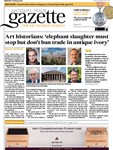THE proceedings issued in October 2016 in the Supreme Court of New York by the Mayor Gallery of London against the Authentication Committee of the Agnes Martin catalogue raisonné raise some intriguing issues around the role played in art commerce by these secretive bodies.
The Mayor Gallery, in Cork Street, sold 13 works by American abstract painter Agnes Martin for $7.2m from 2009-13.
Rejected submissions
Later submissions of these various works to the Authentication Committee were roundly rejected, despite protestations and evidence from the gallery. The result is that the gallery claims it has to refund its clients more than $7m, and is attempting to claim this back from the Authentication Committee.
The Agnes Martin Authentication Committee was set up in the usual way and remains a private body with no statutory or public endorsement.
What is fascinating is that when these authentication bodies – other well-known ones include the Andy Warhol Art and Authentication Board and the Calder Foundation – achieve the status and influence they seek, by very dint of their success they take on legal duties and responsibilities, whether they like it or not.
The New York lawsuit alleges for example that:
Christie’s and Sotheby’s both “recognise the Agnes Martin catalogue raisonné”, assembled by some of the defendants, as the “definitive compilation of authentic artworks of Agnes Martin” so that an Agnes Martin artwork “rejected by defendants is worthless and the defendants have fostered and created this status for themselves”.
In other words, if the defendants had not been so successful in cornering the market for verifying Agnes Martin works, this claim couldn’t be made.
The lawsuit also alleges that Arnold Glimcher, a central member of the Authentication Committee, but also CEO of the Pace Gallery, which represents the estate of Agnes Martin, had a possible conflict of interest which “prevented an objective and fair vetting of submitted artworks”.
The point being made here is that preserving the value of the estate allegedly comes first for Glimcher and authenticating works submitted to the committee may work against this.
The gallery’s pleading goes on to claim that the statements of rejection by the defendants “were made without a careful examination of the facts relating to authenticity and without providing – indeed refusing to provide – information and documents explaining and supporting the decision”.
The pleading also rather flamboyantly proclaims that the “defendants conducted their vetting peremptorily and dictatorially much like a Star Chamber”.
It is alleged that the statements were made with “malice” and “with a reckless disregard for whether the statements were true or false”.
See box (below left) for the ‘legal wrongs’ giving rise to the claim.
Liability denied
All these allegations are made despite the fact that in the signed agreement relating to some of the artworks, the authentication committee make clear that they have no legal liability for the work they are carrying out.
Yet there is no doubt that a privately created body, such as an eminent authentication committee, can inadvertently bring upon itself a legally binding duty of care towards those who use its services – thus becoming a victim of its own success.
The more recognised the body becomes, the more real that duty of care is going to be – something to bear in mind for those who may wish to prepare a catalogue raisonné.
The gallery’s allegations have been vigorously denied, and the case will be hard-fought, though no surprises there. We can all watch it unfold.
Legal ‘wrongs’ in detail
The ‘legal wrongs’ giving rise to the Mayor Gallery claim are variously described as:
- The ‘tort of product disparagement’ (a very American term); tortious interference with the contracts of sale between the Mayor Gallery and their clients;
- Negligent misrepresentations by the defendants to the Mayor Gallery’s clients;
- In the context of the authentication committee having “a unique status” and being recognised in the art world as “the final arbiters of whether an art work purported to be by Agnes Martin is in fact authentic”, the gallery claims that the defendants had a duty to answer the gallery’s request that the defendants provide the reasons they found the Gallery’s new evidence “unpersuasive”.
Milton Silverman is Senior Commercial Dispute Resolution partner at Streathers Solicitors LLP, 44 Baker Street, London










